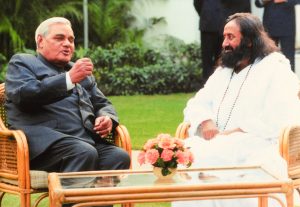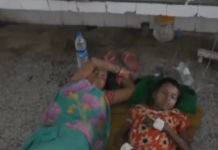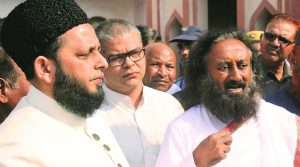 The Supreme Court of India declared final judgment in the Ayodhya dispute on November 9, 2019 ordering the disputed 2.77 acres land to be handed over to a Trust to be created by the Government of India to build Ram Janmabhoomi Temple and alternate site of 5 acres to Sunni Waqf Board for the purpose of building a mosque.
The Supreme Court of India declared final judgment in the Ayodhya dispute on November 9, 2019 ordering the disputed 2.77 acres land to be handed over to a Trust to be created by the Government of India to build Ram Janmabhoomi Temple and alternate site of 5 acres to Sunni Waqf Board for the purpose of building a mosque.
Ever since, many a person(s) and bodies have claimed credit to help resolve the dispute. We bring forth an overview of efforts made by Gurudev Sri Sri Ravi Shankar towards a negotiated settlement of Ayodhya dispute on the basis of information taken from the secretariat of Gurudev Sri Sri Ravi Shankar who believed that trust deficit and breakdown in communication are the main factors behind every conflict.
Ayodhya’s Ramjanmabhoomi-Babri Masjid imbroglio is one of India’s longest-running disputes with a history of over a century. It is the belief and faith of Hindus that Ayodhya, a
city in the northern state of Uttar Pradesh, is the birthplace of one of their most revered deities Lord Rama. It’s believed that an ancient Rama temple was destroyed and a mosque built over it by Babar, the Mughal emperor who conquered India, in 1528. Communal tensions around the issue have simmered since then.
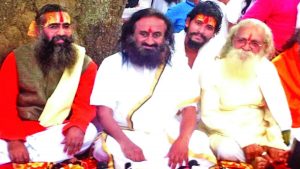 Hindus have a strong sentimental association with the land and so do the Muslims, particularly after the Babri mosque was razed in 1992 by a frenzied mob. The communal riots that broke out in several parts of India in the aftermath of the demolition claimed more than 2,000 lives and property worth billions was damaged.
Hindus have a strong sentimental association with the land and so do the Muslims, particularly after the Babri mosque was razed in 1992 by a frenzied mob. The communal riots that broke out in several parts of India in the aftermath of the demolition claimed more than 2,000 lives and property worth billions was damaged.
Despite seven decades of court battles, a permanent solution continued to elude the dispute, which was mired in political, historical and socio-religious complexities. In an ecosystem, which also included vested interests who did not want the issue to be resolved, it had been highly challenging to build a consensus for a peaceful settlement.
The first steps (2001 -2003)
When Gurudev Sri Sri Ravi Shankar returned to India after addressing the World Economic Forum in Davos in 2001, he had a meeting with the then Prime Minister, Atal Behari Vajpayee. During the meeting, Vajpayee reportedly asked Gurudev whether he could intervene in the resolution of the Ayodhya dispute. At that time, the movement to build a grand Ram Temple at the birthplace of Lord Ram was being intensified by Vishwa Hindu Parishad (VHP).
A peaceful settlement seemed out of sight in a situation where people from both the Hindu and Muslim communities felt wronged. With the intent to build trust and initiate dialogue, Gurudev organised and took part in a series of meetings with stakeholders from both sides between September 2001 and March 2002. He engaged with Hindu and Muslim parties collectively and individually.
He had many meetings in this regard with the late VHP leaders Ashok Singhal, Acharya Giriraj Kishore and Dr. Praveen Togadia. Gurudev also engaged with Muslim leaders including Zafaryab Jilani, and Kamal Farooqui at the office of All India Muslim Personal Law Board at Okhla in New Delhi. During these meetings some parties were keen on exploring a settlement through dialogue. However, their lawyers advised them to wait since the Allahabad High Court was hearing the case and the pronouncement of court verdict could place the parties in a stronger position.
In a subsequent meeting with intellectuals, at Shanti Niketan in New Delhi, Gurudev held discussions with social activist and educationist Dr. Syeda Hameed, president of All India Muslim Majlis-e-Mushawarat Navaid Hamid, veteran journalist Syed Naqvi, members of Parliament Javed Akhtar and Shabana Azmi, and close aide of L K Advani Sudheendra Kulkarni. This meeting yielded a highly positive outcome with most people present agreeing to take the talks forward along the lines proposed by Gurudev. The date and venue for a meeting with a larger representation of stakeholders were fixed.
In a surprising move, Sudheendra Kulkarni, a close aide of then deputy prime minister of India L K Advani, along with Kanchi Shankaracharya Swami Jayendra Saraswati, suddenly started taking the lead in the mediation proceedings. It became clear that he didn’t want Gurudev to be part of it and hence Gurudev took a backseat. However, the ensuing talks didn’t yield much. One common refrain from some Muslim leaders was that they were not treated as an equal partner and were made to take seats lower than that of the Shankaracharya.
With no resolution in sight, Gurudev floated his formula for an amicable settlement in February 2003. This formula was based on values of compassion and forgiveness (See Annexure 4). By the end of 2003, attempts to reach a negotiated settlement had reached a dead-end as the parties failed to reconcile on fundamental points.
Mediation of 29 months
In March 2017, the former Chief Justice of India JS Khehar suggested an out-of-court rapprochement, stating that such “sensitive issues involving religious sentiments” are best resolved by adopting a “give and take approach”. And in June 2017, 92-year-old Ramchandracharya of Nirmohi Akhara, the main plaintiff in the Ayodhya title suit, met Gurudev and appealed to him to start the process for an amicable settlement. The monk was accompanied by a couple of members from the All India Muslim Personal Law Board (AIMPLB).
Gurudev agreed to make a fresh start in the dialogue process at it was in the interest of the nation. Thus began a long journey of 29 months of mediation during which Gurudev met with leaders and original litigants from both sides to find a middle ground. Gurudev facilitated a series of meetings with a wide range of people who could play a role in pushing for a negotiated settlement.
From Nirmohi Akhara to All India Muslim Personal Law Board to Muslim and Hindu bodies to intellectuals, everyone was roped in to work with a vision for lasting peace and harmony in the country. However, premature leakage and frenzied criticism of a sensitive process that was yet to take wings came in the way.
As Gurudev continued the interactions, more and more parties became vocal about their support to the process of finding an amicable settlement. From Syed Rizvi, Chairman of U.P. Shia Central Waqf Board to senior leaders from prominent Hindu outfits such as head of Nirmohi Akhara Mahant Dinendra Das, President of Akhil Bharat Hindu Mahasabha Chandra Prakash Kaushik and other senior office bearers openly voiced support.
Gurudev had fruitful deliberations with leaders such as Mahant Janmejay Sharan, National President of Sri Ram Janmabhoomi Nirman Nyas, Mahant Suresh Das of Digambar Akhara, Maulana Khalid Rasheed Firangi Mahal, Member of AIMPLB, Mahant Suresh Das, Head of Digambar Akhara, Iqbal Ansari, son of the original litigant in the Ayodhya case, Mahant Nritya Gopal Das, President, Sri Ram Janmabhoomi Nyas, Haji Mehboob, one of the main litigants, Mahant Raja Ramchandracharya of Dakor and Mahant Dinendra Das, Head, Nirmohi Akhara, Maulana Tauqir Raza Khan, head of Bareilvi sect of Sunni Muslims with 200 million followers, and Maulana Shahabuddin Razvi, National General Secretary of All India TanzeemUlama-E-Islam and many more.
Gurudev met a large group of Hindu saints and scholars from different parts of India in Kashi in February 2018. He also separately interacted with over 500 imamas from across India through video conferencing and in person meetings. He had an extremely fruitful meeting with senior office bearers of alumni association of Aligarh Muslim University. The outcome of all these interactions was highly positive with a large section of Muslim intellectuals and clergy pledging their support for a peaceful out-of-court resolution.
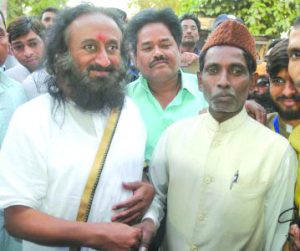 Taking the process of dialogue and trust building closer to the people, Gurudev visited the holy town of Ayodhya on November 15-16, 2017. Gurudev’s proposition, that for a long-standing peaceful solution it was far better for spiritual and religious leaders of both communities to arrive at a win-win solution on their own, found widespread resonance.
Taking the process of dialogue and trust building closer to the people, Gurudev visited the holy town of Ayodhya on November 15-16, 2017. Gurudev’s proposition, that for a long-standing peaceful solution it was far better for spiritual and religious leaders of both communities to arrive at a win-win solution on their own, found widespread resonance.
A court verdict on this emotionally charged issue could lead to one community feeling left out. In all likelihood, a demand for correction could reemerge years later if not settled once for all in an amicable way. In February, 2018, a delegation of senior Muslim leaders came to Bengaluru for further talks with Gurudev. The delegation included mostreputed scholar of Nadwa, (Lucknow) Salman Nadwi and Chairman of UP Sunni Central Waqf Board Zufar Ahmed Faruqi.
The meeting ended with a significant breakthrough. A consensus was built within the Muslim group to relinquish the claim to the disputed land and shift the mosque to another place, in order to strengthen communal harmony in the country. The group of scholars cited Prophet Muhammed’s example of Sulah Hudaibiya (Hudaibiya peace treaty) which affirmed how the Prophet preferred peace over conflict in striking a truce between people of Mecca and Medina cities.
It was unanimously accepted that the above proposal would create a win-win situation in which the Muslims would gain the goodwill of one billion Hindus. It would also put to rest the issue for future generations and coming centuries. Gurudev’s proposal for joint celebrations in the spirit of love and brotherhood was welcomed in this meeting. As part of celebrations, Muslim religious leaders would be invited and honored in the hundreds of thousands of Ram temples spread across the villages and cities of India.
On November 12, 2018 one of the main Muslim petitioners from Ayodhya, Haji Mehboob and prominent Muslim leaders signed a statement pledging support to Gurudev and expressing willingness to work with him for an out-of-court settlement of Ayodhya dispute As Gurudev’s continuous engagements to sensitize people progressed, his proposition for an amicable settlement found more and more takers.
A well-attended seminar of civil society held in March 2018 in Lucknow issued a call to Muslim clerics to engage with Gurudev and amicably resolve the Ayodhya dispute. Prominent Muslim intellectuals also signed separate letters addressed to Maulana Syed Muhammad Rabey Hasani Nadvi, President of AIMPLB and Maulana Syed Arshad Madani,
President of Jamiat Ulama-I-Hind. Gurudev’s efforts to resolve the Ayodhya dispute through amicable and negotiated settlement received support from Dr Frank Islam and Prof Ali Shamsi when he met them in USA in April 2018.
The Roadblocks
While individuals and groups were welcoming and supporting Gurudev’s initiatives, vested interests were out to derail the mediation process. Over the years, the Ayodhya issue has not only turned into India’s most politically sensitive case but also become a cash cow for many on both sides of the dispute. Their interest lies in prolonging the dispute. As a result, vicious attacks were mounted on Gurudev even questioning his motives behind this initiative. Every
time significant advances are made towards the ending of Ayodhya conflict, vested interests disrupt and derail the process.
The common technique used by these forces is to discredit the persons involved by spreading rumours. Maulana Salman Nadvi had to face vicious attacks when he went public with the consensus formula that emerged at the Bangalore meeting with Gurudev on February 8, 2018. In all sincerity, he wanted to arrive at a solution that would promote unity and harmony in the country. Unfortunately, he was falsely accused of making money through this exercise. A few members of AIMPLB even saw to it that he was expelled from the board.
Several people suggested to Gurudev that he shouldn’t get involved in the mediation work and warned him of grave consequences should he continue doing it. Many stakeholders, who expressed support for the process in private meetings, had to deny it in public due to threat to
their lives and reputation. However, Gurudev was undeterred by all this and was willing to go the extra mile to reach a win-win solution that accommodates the sensitivities and sensibilities of both communities. This was possible only through dialogue.
Notwithstanding the vitriolic cacophony in public, a quiet momentum had been building up for many months and gained pace in February 2018. Though people hesitated to speak out in
open, in private most stakeholders had rallied around the solutions for putting a cordial end to the dispute. Support for settlement through mediation continued to pour in. It is a known fact that most Hindus and Muslims have wanted a peaceful solution. If the disputing parties could find a middle ground it would benefit the entire country.
Court-monitored mediation
On March 8, 2019, two weeks after suggesting mediation as an option, the Supreme Court of India directed the parties involved in the Ayodhya case to join a confidential, court-monitored mediation process. Gurudev was officially appointed as one of the three mediators in the matter, by the Supreme Court, along with SC judge F M Kallifulla and senior advocate Sriram Panchu.
The court-monitored mediation began on March 13, 2019. The mediation panel conducted several hearings. The members of the panel met the parties to the dispute collectively and individually. Apart from this, they also met several influencers, decision-makers, and prominent members of society and leaders of all communities.
The Ayodhya mediation committee submitted its first status report to the Supreme Court on July 18, 2019 The court directed the committee to continue working towards a settlement. On July 31, 2019 the panel submitted its second report on the progress made in mediation. At that time some of the parties were not in favour of mediation and the proceedings came to a halt.
However, on September 16, 2019, at the request of two key stakeholders– the Sunni Wakf Board and Nirvani Akhara, the court gave a go-ahead for the resumption of mediation exercise. On October 16, 2019, the Supreme Court appointed mediation panel filed its final report in the apex court in a sealed cover. The report included details of the settlement between the Hindu and the Muslim parties.
There is a visible increase in understanding between people and diffusing of tensions. Most stakeholders want to send out a message of peace and brotherhood and strengthen the fabric of social harmony. Throughout this long engagement, Gurudev worked with the sole objective of maintaining peace and harmony in society by creating a win-win situation in which no community harboured a sense of being wronged.
letters@tehelka.com

